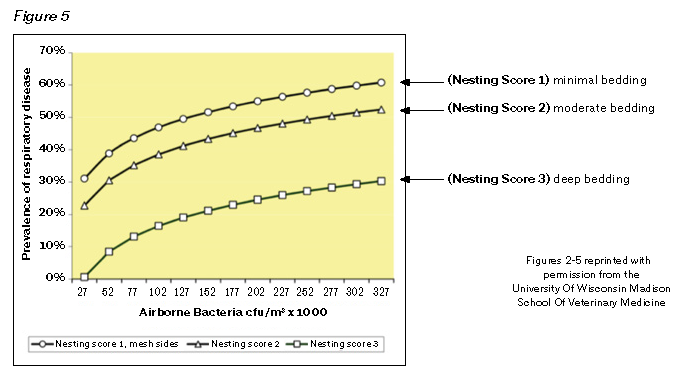The Importance Of Calf Bedding
Click here to view as a pdf: The Importance Of Calf Bedding
By Kaylee Viney
Livestock Specialist
The investment made in young stock and heifers sets the groundwork for future herd performance. There is new research in the industry on how calf bedding not only affects the health and growth of young calves, but its significant impact on future milk production. Bedding type and management have higher importance when faced with cold weather challenges.
Cold Stress in Calves:
The USDA estimates that 95,000 calves die each year due to cold stress and hypothermia1. Factors that predispose calves to cold stress include: calving difficulty, cow nutrition during gestation and colostrum intake1. Mild hypothermia is present when the calf’s core body temperature drops below 100°F. Signs of cold stress include: a hunched posture, shivering, increased heart rate over (70-100 beats per minute) and an increased breathing rate (over 20-40 breaths per minute)1. Behavioral symptoms such as confusion and clumsiness can also be evaluated to determine if cold stress is present1. Lots of dry, lofty bedding is a necessity to combat cold stress in newborn calves.
Bedding Type & Management:
Recently, researchers compared different types of calf bedding to the growth and health of young dairy calves. This study compared sand, wood shavings and long stem wheat straw.
The study found that the wheat straw bedding could absorb the most moisture and provided the most insulation for heat2. Calves on wheat straw bedding had the highest average daily gain and the lowest reported scour days of any bedding material evaluated.
The University of Wisconsin-Madison has conducted studies on the correlation between respiratory disease and calf bedding3. A “Nesting Score” system was developed to compare results of different bedding volumes used. For a significant reduction in the prevalence of respiratory disease, it was found that a nesting score of 3 was desired3. It is recommended that for every 1,000 lbs. of calf body weight, 25 lbs. of long stem wheat straw be used daily in order to achieve this desired nesting score for calves.
The Link to Production:
Bovine respiratory disease is costly, not only in treatment costs but also in reduced growth and future production potential. Research from 2012 estimates the average treatment cost of a single case of calfhood pneumonia to be $15.604. When researchers added indirect costs such as reduced average daily gain, feed efficiency, and carcass value, the cost of a single case of calfhood pneumonia rose to $92.304. Cows that required more than one calfhood pneumonia treatment produced 5% less milk during their first lactation and 10% less milk during their second lactation5.
Overall Takeaway:
Survivors of respiratory disease cost the producer: treatment expense, premature culling, reduced growth, fertility and milk production. Deep bedding with long stem wheat straw has been proven to dramatically reduce the prevalence of bovine respiratory disease in young calves. When cold weather hits, bed calves aggressively to prevent cold stress and pneumonia. Crystal Creek® can help you with your calf needs and questions. Call 1-888-376-6777 today.
Sources:
1 Butler, Lanette, Russ Daly, and Cody Wright. “Cold Stress and Newborn Calves.” (n.d.): n. pag. I Grow. SDSU Extension. Web. <https://igrow.org/up/resources/02-2001-2013.pdf>.
2 Quigley, Jim. “Growth and Health of Calves Housed on Different Bedding Types.” Growth and Health of Calves. DeLaval, n.d. Web. 08 Sept. 2016. <http://www.milkproduction.com/Library/Scientific-articles/Calf-Management/Growth-and-health-of-calves/>.
3 Nordlund, Ken, and Tina Kohlman. OPTIMIZING RESPIRATORY HEALTH IN CALF BARNS (n.d.): n. pag. UW Extension. University of Wisconsin. Web. <http://fyi.uwex.edu/dairy/files/2014/11/Optimizing-Calf-Repiratory-Health.pdf>.
4 Urban, Renata.urban. “Prevention and Control of Influenza.” Morbidity and Mortality Weekly Report 37.23 (1988): n. pag. Livestock Science. Web. <http://livestockscience.in/wp-content/uploads/2012/Bovine_Respiratory_Disease.pdf>.
5 Magnier, Sharon. “The Impact of Early Calfhood Disease.” Veterinary Ireland Journal 4.4 (n.d.): n. pag. Veterinary Ireland Journal. Web. <http://www.veterinaryirelandjournal.com/files/la_may_2014.pdf>.
6, 7, 8 Nordlund, Ken, and Tina Kohlman. Nesting Score 1, 2, 3. Digital Image. University of Wisconsin-Extension. University of Wisconsin, n.d. Web. 12 Sept. 2016.



